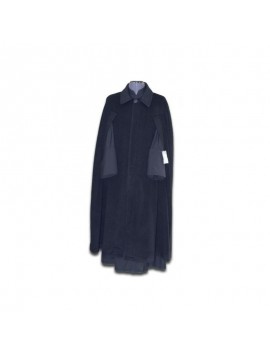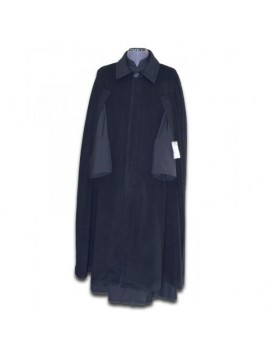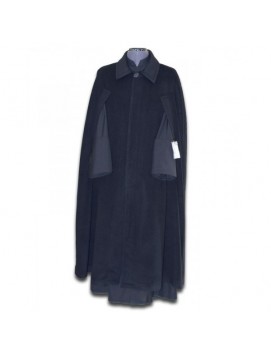No products
Cloaks
Clergy cloaks are a type of outerwear worn by clergy members in various Christian denominations, including Roman Catholic, Anglican, and other denominations. They are made of high-quality materials, such as silk, fleece, or crepe, and are available in various colors, including black, royal blue, Roman purple, and white. Clergy cloaks can be full flared with a hood or have arm slits. They are often decorated with spiritual motifs, such as the Holy Spirit, and are perfect for smart occasions, colder days, or for use at outdoor services. Clergy cloaks can be purchased from various online retailers, and can be custom-made to fit the clergy member's style and preferences. Overall, clergy cloaks are a beautiful and practical way to show devotion and respect for the clergy member's role in the church while enjoying the exquisitely crafted designs that have spiritual significance.
Clergy cloaks are a type of outerwear worn by clergy members in various Christian denominations, including Roman Catholic, Anglican, and other denominations. They are made of high-quality materials, such as silk, fleece, or crepe, and are available in various colors, including black, royal blue, Roman purple, and white. Clergy cloaks can be full flared with a hood or have arm slits. They are often decorated with spiritual motifs, such as the Holy Spirit, and are perfect for smart occasions, colder days, or for use at outdoor services. Clergy cloaks can be purchased from various online retailers, and can be custom-made to fit the clergy member's style and preferences. Overall, clergy cloaks are a beautiful and practical way to show devotion and respect for the clergy member's role in the church while enjoying the exquisitely crafted designs that have spiritual significance.
Clergy Cloaks: A Timeless Emblem of Spiritual Authority
Clergy cloaks, those majestic and flowing garments, have long been a symbol of spiritual authority and devotion within various religious traditions. These cloaks are not just pieces of fabric; they are rich in history, symbolism, and purpose, serving as a visual representation of the clergy's role as intermediaries between the divine and the earthly realms.
The Essence of Clergy Cloaks
Clergy cloaks are more than mere garments; they are a profound expression of commitment and service to a higher calling. Worn by priests, ministers, bishops, and other members of the clergy, these cloaks are a mark of distinction, setting the wearer apart as a servant of the sacred.
Historical Roots and Evolution
The origins of clergy cloaks can be traced back to the early days of Christianity, where clerical clothing was mandated to distinguish clergy from laypeople. Over the centuries, these garments have evolved from simple, everyday attire to the elaborate and symbolic cloaks we recognize today. The Fourth Lateran Council of 1215 played a pivotal role in standardizing clerical attire, including the cassock, which is a precursor to the modern clergy cloak.
Symbolism and Significance
Clergy cloaks carry deep symbolic meaning, representing the wearer's dedication to their spiritual duties. The design and color of the cloak can signify various aspects of the clergy's role and the liturgical season. For instance, certain colors are worn for specific ceremonies or times of the year, reflecting the thematic elements of the religious calendar.
The Clergy Cloak in Different Traditions
The use of clergy cloaks varies across Christian denominations, each with its own traditions and regulations. For example, the Roman Catholic Church has a rich tradition of clerical attire, including the cassock and the surplice, which may be complemented by a cloak during certain ceremonies. Anglican, Eastern Orthodox, and Lutheran traditions also have distinct practices regarding clergy attire, reflecting their theological and cultural heritage.
Modern Adaptations and Variations
Today, clergy cloaks are available in a variety of styles, materials, and colors, catering to the diverse needs and preferences of modern clergy. While black remains a common color, signifying humility and service, other colors like white, purple, and red are used to denote different liturgical seasons and celebrations. Additionally, women clergy have also embraced clerical attire, adapting traditional designs to suit their needs.
The Role of Clergy Cloaks in Liturgy and Ceremony
In liturgical settings, clergy cloaks serve not only as a mark of spiritual authority but also as a visual cue to the congregation, signifying the solemnity and sacredness of the occasion. Whether worn during worship services, processions, or other religious ceremonies, these cloaks help to create an atmosphere of reverence and devotion.
Conclusion: A Living Tradition
Clergy cloaks are a testament to the enduring nature of religious tradition and the unchanging role of the clergy as spiritual leaders. As both a symbol of authority and a garment of service, they remind us of the deep commitment of those who wear them to their faith and their community. In a world of constant change, clergy cloaks stand as a beacon of continuity, linking the past with the present and the earthly with the divine.



